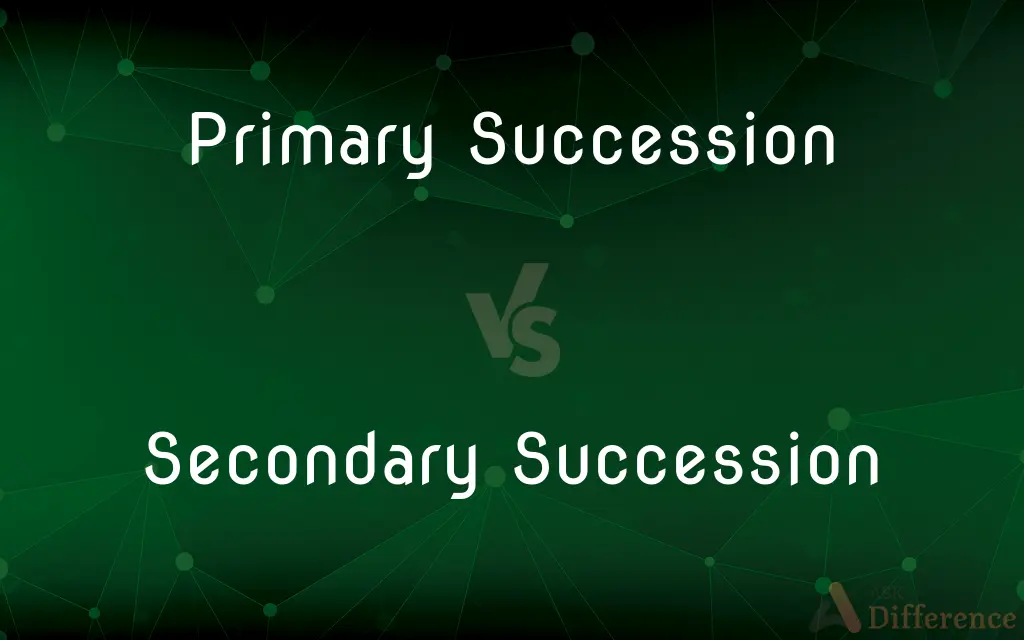Primary Succession vs. Secondary Succession — What's the Difference?
By Tayyaba Rehman — Published on January 16, 2024
Primary succession involves life beginning on barren land, while secondary succession involves the regrowth of life after a disturbance in an existing ecosystem.

Difference Between Primary Succession and Secondary Succession
Table of Contents
ADVERTISEMENT
Key Differences
Primary Succession begins on barren land where no soil exists, such as after a lava flow or on a new island formed by volcanic activity. This process involves pioneer species like lichens and mosses that can survive harsh conditions. These organisms help in soil formation, paving the way for more complex life forms.
Secondary Succession, on the other hand, occurs in areas where an ecosystem has been disturbed or partially destroyed by events like fires, floods, or human activities. Unlike Primary Succession, soil is already present, allowing for a faster recovery of plant and animal life. This process often leads to the reestablishment of a similar ecosystem that existed before the disturbance.
In Primary Succession, the development of a stable ecosystem can take hundreds or even thousands of years. The progression from barren land to a mature ecosystem involves several stages, including the creation of soil, colonization by plants, and the establishment of a diverse array of species.
Contrastingly, Secondary Succession usually takes less time because the soil, containing seeds and nutrients, remains. This leads to a quicker establishment of plant life, which then supports the return of animals and other organisms. The timeline for Secondary Succession can vary, but it's typically faster than Primary Succession.
Primary Succession and Secondary Succession are both natural processes of ecological development, but they start under different conditions and can have varying timelines. While Primary Succession begins from scratch, Secondary Succession rebuilds on an existing foundation.
ADVERTISEMENT
Comparison Chart
Starting Condition
Begins on barren land, no prior ecosystem
Occurs on previously inhabited land
Soil Presence
No initial soil, formed during the process
Soil present, often containing seeds and nutrients
Timeframe
Takes longer, often centuries
Relatively quicker, can be years to decades
Pioneer Species
Lichens, mosses, and hardy plants
Grasses, weeds, and fast-growing plants
Ecosystem Recovery
Development of a completely new ecosystem
Recovery or alteration of a previous ecosystem
Compare with Definitions
Primary Succession
The gradual growth of an ecosystem on barren terrain.
Primary Succession on the rocky cliff led to the formation of a diverse habitat.
Secondary Succession
The regrowth of life in areas where the existing ecosystem was destroyed.
Secondary Succession began in the abandoned farmland, bringing back native species.
Primary Succession
The ecological establishment of life in an area devoid of soil.
After the volcanic eruption, Primary Succession began on the newly formed island.
Secondary Succession
The reestablishment of an ecological community following a disturbance event.
Post-logging, the forest underwent Secondary Succession, gradually regaining its diversity.
Primary Succession
The process of life colonizing uninhabited areas.
The glacier retreat revealed land for Primary Succession to commence.
Secondary Succession
The process of ecosystem recovery in previously inhabited areas.
After the flood, Secondary Succession helped reestablish the wetland ecosystem.
Primary Succession
The initial stage of ecosystem development on lifeless ground.
Primary Succession started with lichens breaking down rocks into soil.
Secondary Succession
The ecological restoration of an area after a disturbance.
Following the forest fire, Secondary Succession rapidly introduced new plant life.
Primary Succession
The development of a biological community in a previously uninhabited and sterile environment.
Over centuries, Primary Succession transformed the barren landscape into a forest.
Secondary Succession
The sequential return of species after an ecological disruption.
The hurricane cleared the forest, allowing Secondary Succession to introduce new flora.
Common Curiosities
What initiates Primary Succession?
Primary Succession starts on bare, lifeless land, like after a volcanic eruption.
Is Secondary Succession faster than Primary?
Yes, because soil and seeds are often already present.
What are pioneer species in Primary Succession?
Lichens and mosses are common pioneer species in Primary Succession.
Can Secondary Succession restore a previous ecosystem?
Yes, it often leads to a similar or altered version of the previous ecosystem.
Does Primary Succession create soil?
Yes, pioneer species in Primary Succession help in soil formation.
What follows after pioneer species in Secondary Succession?
Grasses and fast-growing plants typically follow in Secondary Succession.
What triggers Secondary Succession?
Secondary Succession occurs after a disturbance in an already existing ecosystem, like a fire.
Can human activity trigger Secondary Succession?
Yes, activities like logging or agriculture can lead to Secondary Succession.
Does Secondary Succession always start from scratch?
No, it starts with some elements of the previous ecosystem, like soil and seeds.
How long does Primary Succession take?
Primary Succession can take centuries as it starts without soil.
Can human intervention speed up Secondary Succession?
Yes, through actions like replanting and soil management, the process can be expedited.
Is Primary Succession predictable?
It generally follows a predictable pattern, but specific outcomes can vary.
Is biodiversity higher in later stages of Primary Succession?
Yes, as the ecosystem matures, biodiversity typically increases.
Can Secondary Succession lead to a different ecosystem?
Sometimes, the resulting ecosystem may differ from the original due to various factors.
Are animals involved in Primary Succession?
Initially, it's mostly microbial and plant life, but animals arrive as the habitat develops.
Share Your Discovery

Previous Comparison
Time Sharing Operating System vs. Real-Time Operating System
Next Comparison
IMC vs. MarketingAuthor Spotlight
Written by
Tayyaba RehmanTayyaba Rehman is a distinguished writer, currently serving as a primary contributor to askdifference.com. As a researcher in semantics and etymology, Tayyaba's passion for the complexity of languages and their distinctions has found a perfect home on the platform. Tayyaba delves into the intricacies of language, distinguishing between commonly confused words and phrases, thereby providing clarity for readers worldwide.
















































